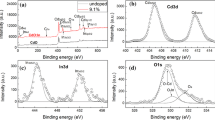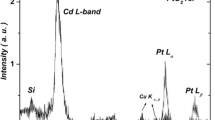Abstract
We investigate theoretically the main aspects of the formation of cadmium oxide thin films (by metal evaporation) relative to non-stoichiometry and partial pressure of oxygen. As a matter of fact, mathematical relationships are obtained from that the Cd and CdO phases coexist when the corresponding chemical reaction begins. In fact, the Cd pressure (equal to the CdO one) is found to be proportional to the oxygen absolute temperature which, in turn, equals the Cd (or CdO) absolute temperature. Moreover, the electron drift-mobility in CdO is obtained as a function of the above temperature and as a function of the oxygen partial pressure. We emphasize that chemical kinetics is studied quantitatively by taking into account that a part of cadmium does not combine with oxygen, that is, stoichiometry vanishes. This means that, initially, CdO is still amorphous. This state occurs when the partial pressure of oxygen is smaller than the so-called optimum value of pressure which, by definition, is the value of the oxygen partial pressure at which the optical transmittance of CdO is maximum. These issues are investigated (by means of theoretical considerations) accurately in consistency with experimental data.
Similar content being viewed by others
Avoid common mistakes on your manuscript.
1 INTRODUCTION
The (strong) influence of the oxygen partial pressure on the electrical and optical properties (and related topics) of cadmium oxide has been investigated experimentally [1–7] and theoretically [8–12]. As we have said before, stoichiometry in CdO thin films vanishes when the involved oxygen partial pressure is smaller than the so-called optimum partial pressure [1]. This originates decreasing optical transmittance at the visible range [1]. In fact, when this takes place, cadmium oxide is still amorphous. There are structural and dynamical disorders (consider the coexistence of Cd and CdO phases before the formation of cadmium oxide) when the partial pressure of oxygen is lower than the above mentioned optimal value. At low partial pressure of oxygen, a given CdO thin film has a composition dominated by excessive CdO phase [1] and, as the aforementioned pressure increases, cadmium oxide is produced reaching crystalline state at the optimum oxygen partial pressure [1, 3–5]. On the other hand, the coexistence of Cd and CdO phases gives rise to a marked change of electrical conductivity which was observed experimentally [1]. Above the optimum partial pressure of oxygen, there is a decrease in conductance, which is due to decreasing number of oxygen vacancies, giving rise to diminishing the electron concentration (CdO is only n-type) [1]. Increased partial pressure of oxygen produces crystal growth [1–7]. Beyond this value of pressure, electrical drift mobility diminishes [1]. This fact arises from increasing grain scattering due to a big number of small crystallites [1].
The aim of the present article is performing a theoretical-analytical study on the chemical kinetics associated with the formation of cadmium oxide (by metal evaporation) in relation to its amorphous state. As we have said in section 1, at low oxygen partial pressure, Cd and CdO phases coexist in this state but the composition of a CdO film is dominated by an excess of cadmium oxide [1]. Then we will develop an accurate theoretical approach for elucidating the key aspects of the chemical kinetics in question relative to the notorious influence of the partial pressure of oxygen upon the electrical properties of cadmium oxide in amorphous state, that is, when CdO crystals are not still formed. As a matter of fact, for the first time, useful quantitative relationships will be obtained in terms of pressure and temperature of the Cd and CdO phases. In particular, the electron drift-mobility will be determined.
2 THEORETICAL FORMULATION
The formation of cadmium oxide takes place after the following reaction:
With respect to reaction (1), we apply the mass-action law (Guldberg-Waage law) so it follows:
where, of course, \({{k}_{c}}\) is the equilibrium constant relative to concentrations.
On the other hand, assuming that (1) occurs by metal evaporation [1–7], we have the following expression which gives the corresponding equilibrium constant relative to pressure:
In addition, one has:
where \(T\) denotes absolute temperature and \(\Delta \) is the usual molecular difference of (1) so we have that \(\Delta = 0\), which by formula (4) leads to that \({{k}_{c}} = {{k}_{p}}\).
The basic experimental procedure in the context of our study is vacuum evaporating elemental cadmium in the presence of oxygen plasma [1–7] (reactive evaporation). In this context, the influence of the partial pressure of oxygen on the electrical and optical properties of CdO is certainly significant [1–7]. On the other hand, when CdO is initially formed, the Cd and CdO phases coexist [1] (see section 1). When this occurs, CdO is amorphous and non-stoichiometry takes place [1] (the oxygen partial pressure is lower than the optimum value) (see section 1). The above coexistence implies that \({{P}_{{{\text{CdO}}}}} = {{P}_{{{\text{Cd}}}}}\). Combining this with relation (3), regarding that \({{k}_{c}} = {{k}_{p}}\), and taking \({{P}_{{{{{\text{O}}}_{{\text{2}}}}}}} \equiv P\) for the sake of brevity, then one has:
Since, in the amorphous state, a part of cadmium does not combine with oxygen [1] (non-stoichiometry, see section 1) then \({{k}_{c}}\) diminishes, which agrees with formula (5) because \(P\) is relatively small in the amorphous state.
On the other side, noting that the oxygen temperature is the same as the cadmium one, it follows:
Inserting (6) into (5), we get:
Assuming CdO biased by a relatively weak uniform and static electric field of magnitude \(E\), we are interested in the electron drift-mobility, namely, \(\mu = {v \mathord{\left/ {\vphantom {v E}} \right. \kern-0em} E}\) where \(v\) is the magnitude of the electron velocity. In relation to this velocity, the equipartition theorem reads:
where \(m{\kern 1pt} ^*\) is the electron effective mass and \({{k}_{B}}\) is the Boltzmann’s constant.
On the other hand, we have:
Replacing (9) into (8), from \({1 \mathord{\left/ {\vphantom {1 T}} \right. \kern-0em} T}\) putting \(T\) on the right-hand side and differentiating both sides of the resulting expression, it follows:
Inserting (7) into (10) and considering that \({{k}_{B}} = {R \mathord{\left/ {\vphantom {R {{{N}_{A}}}}} \right. \kern-0em} {{{N}_{A}}}}\) (where \({{N}_{A}}\) is the Avogadro’s constant), then one gets:
By formula (5) one has that \({{P}_{{{\text{Cd}}}}} = {{k}_{c}}P\) which, inserted into (11), yields:
Finally, taking into account that \(\mu \left( P \right) = {{v\left( P \right)} \mathord{\left/ {\vphantom {{v\left( P \right)} E}} \right. \kern-0em} E}\) and Eq. (12), the electron drift-mobility reads:
Relation (13) tells us that \(\mu \left( P \right) \propto \sqrt P \), which agrees qualitatively with experimental data [1].
3 CONCLUSIONS
We have developed a theoretical approach for elucidating key questions related to the kinetics and electron transport in amorphous cadmium oxide formed by metal evaporation. Thin films have been examined. In fact, we have arrived at formula (13) as main result of our formulation. This result is certainly relevant because it provides the electron drift-mobility in amorphous CdO as a function of the partial pressure of oxygen. At this point, we wish to emphasize again the special role of the aforementioned pressure in the deposition process of CdO. Non-stoichiometry of this material before arriving at its crystalline state has been investigated satisfactorily. Finally, we should say that our method can be extrapolated to other important cases in Physical Chemistry and Electrochemistry.
REFERENCES
C. Sravani, K. T. R. Reddy, and P. J. Reddy, Mater. Lett. 15, 356 (1993).
A. A. Dakhel, Curr. Appl. Phys. 11, 11 (2011).
F. C. Eze, Nuovo Cim. D 20, 1421 (1998).
F. C. Eze, Global J. Pure Appl. Sci. 9, 567 (2003).
F. C. Eze, Mater. Chem. Phys. 89, 205 (2005).
Y. Hames and S. E. San, Solar Energy 77, 291 (2004).
D. J. Seo, J. Korean Phys. Soc. 45, 1575 (2004).
M. A. Grado-Caffaro and M. Grado-Caffaro, Mod. Phys. Lett. B 9, 1631 (1995).
M. A. Grado-Caffaro and M. Grado-Caffaro, Mod. Phys. Lett. B 18, 1255 (2004).
M. A. Grado-Caffaro and M. Grado-Caffaro, Phys. Lett. A 372, 4858 (2008).
M. A. Grado-Caffaro and M. Grado-Caffaro, Mod. Phys. Lett. B 29, 1550206 (2015).
M. A. Grado-Caffaro and M. Grado-Caffaro, Russ. J. Phys. Chem. A 92, 2723 (2018).
Author information
Authors and Affiliations
Corresponding author
Ethics declarations
The authors declare that they have no conflicts of interest.
Rights and permissions
About this article
Cite this article
Grado-Caffaro, M.A., Grado-Caffaro, M. On Non-stoichiometry and Partial Pressure of Oxygen in CdO thin Films. Russ. J. Phys. Chem. B 16, 47–49 (2022). https://doi.org/10.1134/S1990793122010201
Received:
Revised:
Accepted:
Published:
Issue Date:
DOI: https://doi.org/10.1134/S1990793122010201




